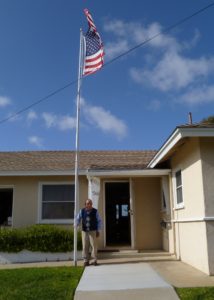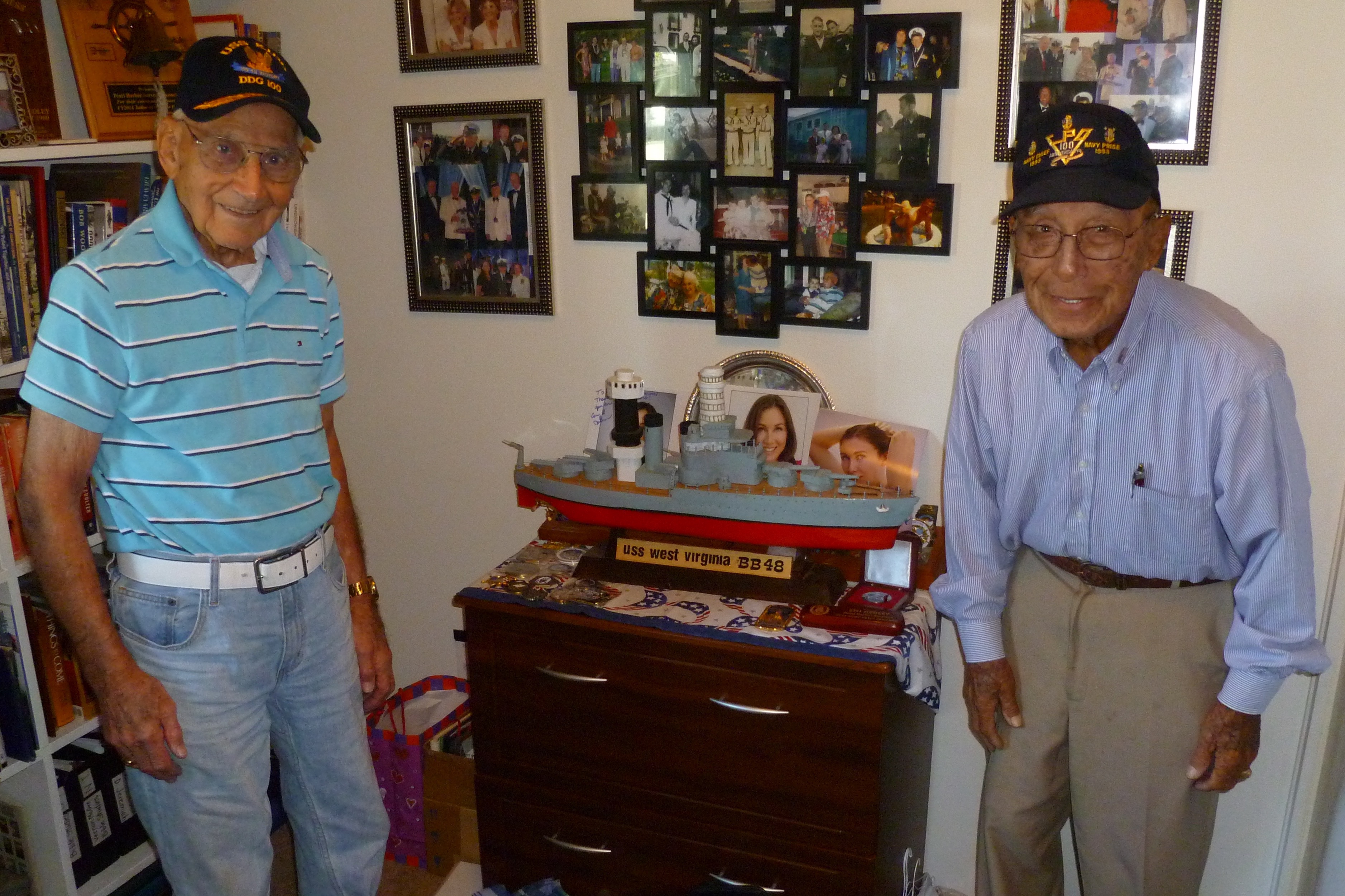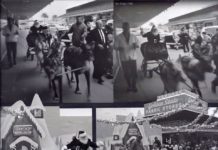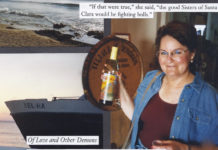Robert Garcia (97) and Stuart Hedley (95) are a couple of old salts who, for over 45 years, have lived a few blocks from each other in North Clairemont. A few days before Thanksgiving, they finally met for breakfast at Troy’s and shared their common experiences from 75 years ago.
On the morning of Sunday, December 7, 1941, “…a date which will live in infamy,” Hedley was a young, 20-year-old seaman first class boatswain mate aboard the USS West Virginia (BB-48), one of eight battleships peacefully moored along Battleship Row in Pearl Harbor, Hawaii. In the far waters of the western Pacific, Garcia, a 22-year-old gunner’s mate petty officer 3rd class on the heavy cruiser USS Portland (CA-33), was transporting ordnance from Hong Kong to French Indochina (Vietnam).
The world changed that day…
In an unprovoked surprise attack, Japanese warplanes bombed Pearl Harbor. Hedley noted ruefully, “My (scheduled) picnic was off.” A shipmate had borrowed his dress shoes on Saturday night, so he went to retrieve them. He stopped for a cup of coffee when the call rang out, “Away Fire and Rescue Party.” Hadley was forced to jump into the water as flames engulfed his ship. His picnic would be placed on hold for almost four years.

Four battleships were sunk that fateful day. Three were raised to fight the Japanese, but the USS Arizona (BB39) and her crew of 1,177 remain untouched and are commemorated as a revered national memorial at Pearl Harbor. Over 2,008 American sailors lost their lives during the sneak attack.
Garcia, the more laconic of the two, said, “I remember thinking, ‘I guess we’re at war.'” The retired Master Chief Petty Officer is a master of understatement. Instinctively, he knew the war would be long and horrific. The Portland would see extensive action, including the Battle of the Coral Sea, Midway and was torpedoed during the Guadalcanal Campaign. The Portland received 16 battle stars.
After Pearl Harbor, Hedley transferred to the heavy cruiser USS San Francisco (CA-38). The Frisco earned 17 battle stars that included action in the Naval Battle of Guadalcanal. Although the military advances of Imperial Japan were stopped on land and sea at Guadalcanal, it would take two and a half more grueling years of war until peace was achieved.

Crew of the USS New Mexico load ammunition magazines during World War II (courtesy Robert Garcia)
Robert Garcia also served on the light cruiser USS Santa Fe (CL-60) and battleship USS New Mexico (BB-40). He was initially assigned to a 14″ gun turret on the battleship, but later placed in charge of twenty-two port side .50mm machine gun mounts. The New Mexico came under Kamikaze attacks in the Philippines and during the bombardment of Okinawa. He remembers a close call, “Our positions were exposed and a bullet whizzed right past my head while we were being strafed.”
On September 2, 1945 (“VJ Day” – Victory over Japan), Chief Garcia and the New Mexico were in Tokyo Harbor when Japanese foreign minister Mamoru Shigemitsu signed the Instrument of Surrender on behalf of Emperor Hirohito aboard the USS Missouri (BB67). The war was over.
Hedley claims the Navy symbolically wanted the surrender ceremony to be held aboard the West Virginia since it was one of the battleships that survived Pearl Harbor. He complains that Harry Truman’s daughter, Margaret, had christened the Missouri in 1944 and the president was a native of Independence, Missouri.
According to naval records, the USS Missouri was the flagship of the Third Fleet and had the most available deck space.
How did these men become sailors? Robert Garcia’s father returned from the trenches of World War I to marry his sweetheart in Ventura, California. Nine months later, Robert was born. He has a 1926 picture of himself proudly wearing a sailor suit his mother and grandmother made on a foot treadle sewing machine. It was taken when he was as a first grader at Holy Cross School in Ventura. Garcia always knew his destiny was with the U.S. Navy.

Stuart Hedley is from Upstate New York. Problems with his stepmother caused him to leave home and drop out of high school. His father had been a Navy pilot during WWI, but, in 1939, Stuart was too short (4’11”) and light (112#) to join the Navy. Instead, he went into the Civilian Conservation Corps (CCC) for a year until he added enough inches and pounds to enlist. “When I hit 122#, I was in the Navy,” he laughed. Pay for a seaman recruit in 1940 was $21 a month.
Hedley retired as a chief petty officer after 20 years of service in 1960. Master Chief Garcia put in 27 years with the Navy.
Stuart Hedley, who was recently reelected president of the Pearl Harbor Survivors Association for the fifth year, contends unequivocally, “There’s no doubt in my mind that Roosevelt orchestrated the attack.”
Over twenty times a year, he speaks to young people, because they don’t understand World War II. He also delivers two important messages for the kids. Stay in school to graduate and learn to love one another.
Hedley will be spending 10 days in Hawaii with The Greatest Generation Foundation for the 75th Anniversary of Pearl Harbor. Garcia is circumspect and rarely attends veterans events.
He doesn’t have plans for Pearl Harbor Day, but one thing is certain.

The morning of December 7, 2016, he will raise the American flag outside his home as he does every day.
You are encouraged to fly your flag on December 7, 2016 to honor those who have fought and died for our freedom.
Bill@Clairemonttimes.com





